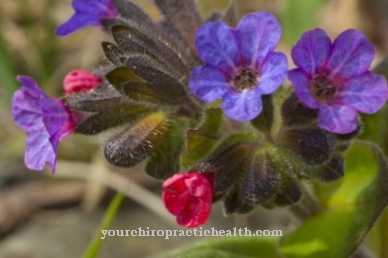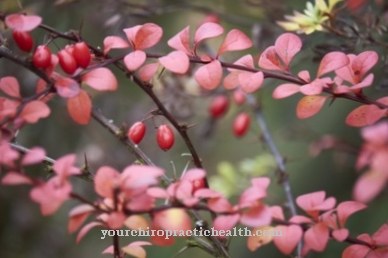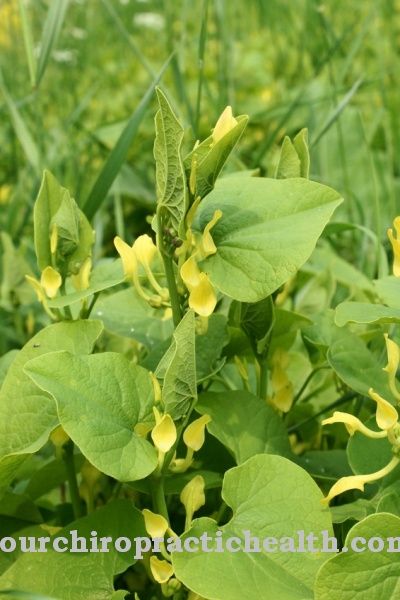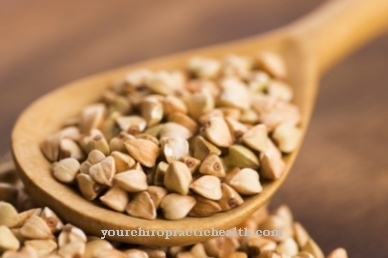Occurrence & cultivation of the real lungwort

The botanical name of the genus is derived from the word "pulmonarius", which means something like "lung disease". This also gives the herb its German name. The name probably comes from the use of the plant as a medicinal herb for lung problems. The plant is persistent and herbaceous. The parts of the herb lying above the ground are coarsely hairy, the stems slightly branched.
Lungwort has simple and slightly hairy leaves and stalked, large rosette leaves. Its inflorescences are terminal, the flowers hermaphroditic and five-fold. The shape of the flowers forms a bell and is very reminiscent of that of cowslips. Nevertheless, both plants belong to different families. After the flowering period, the sepals enlarge. Their color is usually red at first, but later turns blue to purple. The plant has this color change in common with other plants from the predatory family.
The plant is pollinated by bumblebees and butterflies, while ants spread the seeds. Lungwort is native to Central Europe. It is found in sparse deciduous forests and on the edges of forests, where it is found in larger groups. The optimal soil is chalky and as moist as possible. The perennial plant grows up to 20 cm high and its collection time is between May and June.
Effect & application
In shady places, lungwort serves as a so-called ground cover and is used as an ornamental plant. The plant is also used in the kitchen. The raw and cooked leaves of Pulmonaria officinalis can be eaten. Their slightly bitter and cabbage-like mild taste is particularly suitable for wild herb salads and soups. Older leaves can also be prepared and eaten similar to spinach. The herb is also part of the wormwood production.
The herb has additional uses in folk medicine. It has been used there since the Middle Ages. The abbess Hildegard von Bingen already described the effect of lungwort on the respiratory tract in her work "Causa et Curae". Even if it is rarely used as a medicinal herb today, it has a positive effect on lung diseases and various other ailments. It contains silica, mucilage and saponins, but also tannins and allantoin. There are also flavonoids and tannic acid.
The lungwort is mainly used as a tea. It can either be brewed as a tea or made into a mixed tea with other herbs. Pouring one or two teaspoons of hot water over them is enough to make effective lungwort tea. After the tea has steeped for ten minutes, it can be strained and drunk in small sips. Up to three cups a day is recommended. After six weeks of continuous use, a short break should be taken to prevent side effects or immunization.
This prevents habituation and maintains its effectiveness. This basically applies to all stronger remedies. Externally, the tea can also be used to treat wounds in poultices, washes and baths. Another application is the processing of lungwort into powder. Dried cabbage can be grated and then mixed with lukewarm milk. Honey can also be added for flavor.
Importance for health, treatment & prevention
In folk medicine, the dried herb is called Pulmonariae herba designated. The above ingredients not only relieve irritation, but also have an expectorant effect. Therefore, lungwort is used for hoarseness and respiratory diseases. It is also used for colds or bladder problems and diarrhea. It is said to strengthen the kidneys and has a positive effect on digestion and the urinary tract.
In homeopathy there are also tinctures made from lungwort, which are used against bronchitis and asthma. The herb strengthens the lungs and makes it easier to cough up. In the past, the herb was also used against the widespread pulmonary tuberculosis, which was viewed as a plague - if not an epidemic - at that time. The contained tannins and the high allantoin content also promote wound healing. Therefore, the tea or a tincture can also be applied externally to wounds or an envelope can be placed around the affected area. Allantoin is the main active ingredient in comfrey, which is why lungwort can be used similarly.
Despite the positive effects of lungwort, it is rarely used in conventional medicine. The reason for this are the possibly contained pyrrolizidine alkaloids, which could have a negative impact on health. So far there has been insufficient research into the effects of the herb. In addition, the ingredients have not been adequately investigated.
Due to a lack of studies, the herb is therefore officially not said to have any therapeutic effects. In addition, the real lungwort should not be confused with other varieties. If in doubt, the intake of lungwort should be discussed with a homeopath or alternative medicine.
























.jpg)



